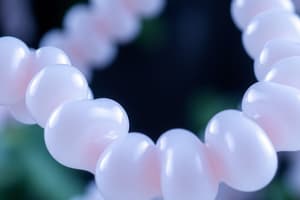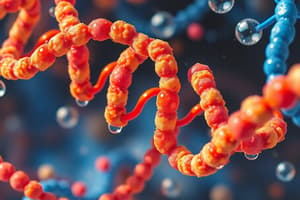Podcast
Questions and Answers
What is the primary function of carbohydrates in living organisms?
What is the primary function of carbohydrates in living organisms?
- Long-term energy storage
- Insulation and protection
- Making up structural components of cells
- Short-term energy storage (correct)
Which statement correctly describes the difference between monomers and polymers?
Which statement correctly describes the difference between monomers and polymers?
- Monomers are always proteins, and polymers are always carbohydrates.
- Monomers are small units; polymers are complex structures made of monomers. (correct)
- Monomers can form other monomers instead of polymers.
- Monomers do not contain carbon, while polymers do.
What is the role of phospholipids in cell membranes?
What is the role of phospholipids in cell membranes?
- Facilitate cell signaling
- Serve as the cell's genetic material
- Provide energy storage for the cell
- Make the membrane selectively permeable (correct)
Which macromolecule stores the most energy per gram?
Which macromolecule stores the most energy per gram?
What is a key function of proteins in the human body?
What is a key function of proteins in the human body?
Which of the following is a characteristic of lipids?
Which of the following is a characteristic of lipids?
Which macromolecule is primarily composed of fatty acids?
Which macromolecule is primarily composed of fatty acids?
What role do antibodies play in the body?
What role do antibodies play in the body?
What occurs during the G1 phase of the cell cycle?
What occurs during the G1 phase of the cell cycle?
Which event marks the beginning of cytokinesis?
Which event marks the beginning of cytokinesis?
Which of the following statements about photosynthesis is correct?
Which of the following statements about photosynthesis is correct?
How many identical daughter cells result from mitosis?
How many identical daughter cells result from mitosis?
Which process involves the movement of materials against a concentration gradient?
Which process involves the movement of materials against a concentration gradient?
In which part of the chloroplast does the Calvin Cycle occur?
In which part of the chloroplast does the Calvin Cycle occur?
Which phase of cellular respiration occurs in the mitochondria?
Which phase of cellular respiration occurs in the mitochondria?
What is the main purpose of the cell cycle?
What is the main purpose of the cell cycle?
What is a key characteristic of eukaryotic cells compared to prokaryotic cells?
What is a key characteristic of eukaryotic cells compared to prokaryotic cells?
Which process primarily breaks down glucose in cellular respiration?
Which process primarily breaks down glucose in cellular respiration?
What is the primary function of nucleic acids?
What is the primary function of nucleic acids?
Which component is NOT part of a nucleotide?
Which component is NOT part of a nucleotide?
What is the effect of increasing temperature on the rate of a chemical reaction?
What is the effect of increasing temperature on the rate of a chemical reaction?
Which type of cell does NOT have a defined nucleus?
Which type of cell does NOT have a defined nucleus?
What characterizes facilitated diffusion?
What characterizes facilitated diffusion?
Which solution would cause a cell to swell?
Which solution would cause a cell to swell?
How do enzymes affect chemical reactions?
How do enzymes affect chemical reactions?
Which process uses vesicles to transport materials out of a cell?
Which process uses vesicles to transport materials out of a cell?
ATP is primarily used for which of the following?
ATP is primarily used for which of the following?
What is the primary role of producers in an ecosystem?
What is the primary role of producers in an ecosystem?
Which of the following reactions is exothermic?
Which of the following reactions is exothermic?
What is one key characteristic of molecular pumps?
What is one key characteristic of molecular pumps?
What happens to the energy when ATP is converted to ADP?
What happens to the energy when ATP is converted to ADP?
Which macromolecule is NOT primarily broken down for energy?
Which macromolecule is NOT primarily broken down for energy?
Flashcards
Macromolecules
Macromolecules
Large, complex, carbon-containing molecules essential for life, including carbohydrates, lipids, proteins, and nucleic acids.
Monomers
Monomers
The basic units that make up larger molecules. Imagine them like individual bricks.
Polymers
Polymers
Complex structures formed by the joining of many monomers. Like a wall made of bricks.
Carbohydrates
Carbohydrates
Signup and view all the flashcards
Lipids
Lipids
Signup and view all the flashcards
Phospholipids
Phospholipids
Signup and view all the flashcards
Proteins
Proteins
Signup and view all the flashcards
Enzymes
Enzymes
Signup and view all the flashcards
What is the cell cycle?
What is the cell cycle?
Signup and view all the flashcards
What is Interphase?
What is Interphase?
Signup and view all the flashcards
What happens during the S phase of Interphase?
What happens during the S phase of Interphase?
Signup and view all the flashcards
What is Mitosis?
What is Mitosis?
Signup and view all the flashcards
What is Cytokinesis?
What is Cytokinesis?
Signup and view all the flashcards
What happens in prophase of Mitosis?
What happens in prophase of Mitosis?
Signup and view all the flashcards
What happens in metaphase of Mitosis?
What happens in metaphase of Mitosis?
Signup and view all the flashcards
What happens in anaphase of Mitosis?
What happens in anaphase of Mitosis?
Signup and view all the flashcards
What happens in telophase of Mitosis?
What happens in telophase of Mitosis?
Signup and view all the flashcards
What is cytokinesis?
What is cytokinesis?
Signup and view all the flashcards
Ecology
Ecology
Signup and view all the flashcards
Producer
Producer
Signup and view all the flashcards
Consumer
Consumer
Signup and view all the flashcards
Herbivore
Herbivore
Signup and view all the flashcards
Carnivore
Carnivore
Signup and view all the flashcards
Omnivore
Omnivore
Signup and view all the flashcards
Detritivore
Detritivore
Signup and view all the flashcards
Food Chain
Food Chain
Signup and view all the flashcards
Food Web
Food Web
Signup and view all the flashcards
Trophic Levels
Trophic Levels
Signup and view all the flashcards
Energy Flow
Energy Flow
Signup and view all the flashcards
Photosynthesis
Photosynthesis
Signup and view all the flashcards
Cellular Respiration
Cellular Respiration
Signup and view all the flashcards
Biomass
Biomass
Signup and view all the flashcards
Population Ecology
Population Ecology
Signup and view all the flashcards
Study Notes
Macromolecules
- Macromolecules are large organic molecules, primarily carbon-based, forming all living organisms.
- Examples include carbohydrates, lipids, proteins, and nucleic acids.
- Macromolecules are typically polymers assembled from monomers.
- Monomers are small, basic subunits; polymers are large, complex structures composed of monomers.
- Carbohydrates: Primary function is short-term energy storage, also involved in structure, transport, and signaling. Found in sugars and starches; 4 calories/gram.
- Lipids: Primary function is long-term energy storage, also provide insulation, protection, and structural components like phospholipids (cell membranes). Found in fats, oils, phospholipids, and steroids; 9 calories/gram. Phospholipids have a hydrophilic head and hydrophobic tails, forming a bilayer in cell membranes.
- Proteins: Diverse functions (enzymes, hormones, structural components, transport, antibodies, movement, receptors); the most structurally and functionally diverse macromolecule. 4 levels of protein structure (primary, secondary, tertiary, and quaternary); function is determined by its shape. Source of energy in the food we eat.
- Nucleic acids (DNA and RNA): Informational molecules storing and transmitting genetic information required to make proteins. Monomers = nucleotides. Never broken down as an energy source.
Enzymes and Biochemical Reactions
-
Enzymes are primarily proteins that accelerate biochemical reactions by lowering activation energy.
-
They act as catalysts; not consumed in the reaction and can be reused.
-
Enzymes bind to reactants (substrates), aiding in bond breaking/forming, liberating a product.
-
Factors affecting reaction rate: temperature, pH, substrate concentration, and catalysts (enzymes).
-
Competitive inhibitors slow reactions.
-
Key types of chemical reactions include:
- Endothermic reactions absorb energy (e.g., photosynthesis).
- Exothermic reactions release energy (e.g., cellular respiration).
- Metabolic reactions are enzyme-controlled.
Cell Theory and Organelle Structures and Functions
- Cell theory:
- All living things are made of cells.
- Cells are the basic units of life.
- All cells come from pre-existing cells.
- Two cell types: prokaryotic and eukaryotic.
- Unicellular organisms consist of a single cell; multicellular organisms are composed of many cells that form tissues, organs, and organ systems.
Cell Transport
-
Two main categories: passive and active transport.
-
Passive transport requires no energy input, moving substances down concentration gradients (high to low concentration). E.g. Simple diffusion, facilitated diffusion, osmosis.
-
Active transport requires energy (ATP) to move materials against concentration gradients (low to high concentration). Examples include molecular pumps, endocytosis, and exocytosis.
-
Simple diffusion: Molecules move from high to low concentration across the membrane until equilibrium is reached. Examples include oxygen and carbon dioxide.
-
Facilitated diffusion: Transport proteins aid in molecule movement across the membrane, which are too large to diffuse freely.
-
Osmosis: Water movement across cell membranes to equalize water concentration.
- Hypertonic solution: Higher solute concentration; water moves out of the cell.
- Hypotonic solution: Lower solute concentration; water moves into the cell.
- Isotonic solution: Equal solute concentration; no net water movement.
-
Molecular pumps: Protein channels that use energy to move molecules against their gradient. Examples include sodium-potassium pumps.
-
Endocytosis: Bulk transport of substances into the cell using vesicles. Examples include phagocytosis and pinocytosis.
-
Exocytosis: Bulk transport of substances out of the cell using vesicles. Examples include hormone release and neurotransmitter release.
ATP
- Adenosine triphosphate (ATP): A molecule that stores energy for cellular processes.
- ATP structure: Adenine, ribose sugar, and three phosphate groups.
- ATP —> ADP + P + energy (exothermic).
- ADP + P + energy —> ATP (endothermic).
Energy Flow
- Producers (autotrophs): Capture energy from non-living sources (e.g. sunlight) and convert it.
- Consumers (heterotrophs): Obtain their energy by consuming other organisms; herbivores, carnivores, omnivores, detritivores
Photosynthesis and Cellular Respiration
- Photosynthesis: Conversion of light energy into chemical energy (sugars).
- Cellular respiration: Breakdown of sugars to release usable energy (ATP).
- Know the chemical formulas for each
- Know the location of these reactions (chloroplasts and mitochondria). The Electron Transport Chain is a key step in both photosynthesis and cellular respiration, though different names are used in the context of each process.
Cell Cycle
- Cell cycle: Repeated pattern of growth, DNA duplication, and cell division.
- Three main phases:
- Interphase (growth): G1, S (synthesis), & G2 phases; DNA replication occurs in S.
- Mitosis (division): Prophase, metaphase, anaphase, telophase.
- Cytokinesis (cytoplasm separation).
Studying That Suits You
Use AI to generate personalized quizzes and flashcards to suit your learning preferences.





